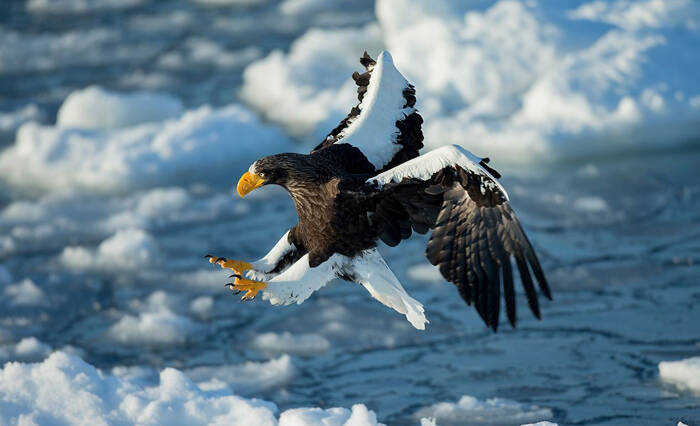Haliaeetus pelagicus
IUCN
LCBasic Information
Scientific classification
- name:Haliaeetus pelagicus
- Scientific Name:Haliaeetus pelagicus,Aquila pelagica,Stellers Sea Eagle,Steller's eagle, sea eagle, golden eagle
- Outline:Raptor
- Family:Falconiformes Accipitridae S.Eagle
Vital signs
- length:101-104cm
- Weight:4.85kg
- lifetime:20-25years
Feature
The largest sculpture in the world
Distribution and Habitat
Non-breeding areas: China, Japan, South Korea, North Korea and South Korea.
Resident bird: Russian Federation (East Asia).
Non-breeding area (wandering): United States.
Breeding in the eastern coast of Siberia, Kamchatka Peninsula, Sakhalin Island, North Korea and Sakhalin Island, Amur River Delta, Kamchatka Peninsula. Wintering in Hokkaido, Japan, Ryukyu Islands, Aleutian Islands, Kodiak Island and North Korea. China is produced in Heilongjiang, Liaoning, Hebei, Shanxi and Taiwan. This species is distributed in the Honghe Swamp Nature Reserve in Heilongjiang, but there is no confirmed breeding. Most of the rest of the area are migratory birds, occasionally wintering in Taiwan.
Steller's Sea Eagle mainly inhabits coastal and river valley areas, and sometimes also enters inland areas far from the sea along the river. Altitude 3600-3800 meters.
Breeding near larger rivers (mainly in lower reaches) or lakes along the coast and inland, where there are mature trees. In M
Appearance
The head of the Steller's sea eagle is dark brown with gray-brown vertical stripes, which looks like tiger spots, hence its name. It is large in size and is characterized by a large yellow beak. Its body feathers are mainly dark brown, its iris, beak and feet are all yellow, and its claws are black. The forehead, shoulders, waist, upper and lower tail coverts and wedge-shaped tail feathers are all white. The forehead and wing coverts of the Korean subspecies are not white, and the body color is also darker. It has 14 tail feathers, 2 more than other sea eagles of the same genus. Viewed from above when flying, the white on the waist, tail feathers and leading edges of the wings are in sharp contrast with the black wings and the rest of the upper body; viewed from below, the white wing edges, white lower tail coverts and tail feathers are in sharp contrast with the black ones. The contrast on the lower body is also very strong.
Their sharp eyes, strong and accurate claws, and pow
Details
Stellers Sea Eagle, also known as Stellers Sea Eagle in English, is a large bird of prey with two subspecies.

The Steller's Sea Eagle has only one named subspecies in China, which is extremely rare and has only been recorded in Luannan, Hebei, Yuci, Shanxi, Dalian and Yingkou, Liaoning, Hunchun, Jilin, Fuyuan, Heilongjiang, and Hsinchu and Chiayi, Taiwan. Except for Taiwan, where the bird is a stray, the residence situation in other places is also unclear. Jilin and Liaoning may be summer migrants, Hebei may be winter migrants, and Shanxi may be migratory birds.
Most Steller's sea eagles migrate south to Japan's Kuril Islands and Hokkaido to overwinter when winter comes.
Steller's sea eagles fly slowly, often gliding, circling in the air, or standing on rocky shores, tree branches, or sand dunes on the shore for a long time. In winter, they move in groups, often gliding and circling in the sky, and their movements are extremely alert. In winter, they move in groups. They are the largest birds of prey in the sky over the bay. They have alert eyes and pay attention to the movements of prey at any time. They are agile and often hit the target with one strike. When hunting, Steller's sea eagles will hover 6-7 meters above the water or wait in shallow water.
The main food of Steller's sea eagles is fish, especially salmon and trout. In addition to fish, they sometimes hunt some birds and mammals, and also eat carrion. They also hunt young seals. Although few people have studied their foraging habits, their food is roughly the same as that of their close relatives, the bald eagle and the white-tailed sea eagle. However, unlike the fishing eagle and the osprey, which are more specialized in their diet, they also eat large and medium-sized birds such as wild ducks, geese, and swans, and small and medium-sized mammals such as hares, mice, and foxes, as well as crustaceans, baby seals, and the carcasses of fish, sea beasts, etc.
The call of the Steller's sea eagle is deep and hoarse, which can remind people of the roar of a tiger; the hoarse bark is kyow-kyow-kyow; when fighting for food or resting, it makes a strong kra, kra, kra, kra call.
Listed in the IUCN Red List of Threatened Species (IUCN) 2016 ver 3.1 - Vulnerable (VU).
Listed in the CITES Appendix II of the Washington Convention.
Listed in the first level of China's National List of Key Protected Wildlife (February 5, 2021).
Protect wildlife and eliminate game.
Maintaining ecological balance is everyone's responsibility!








